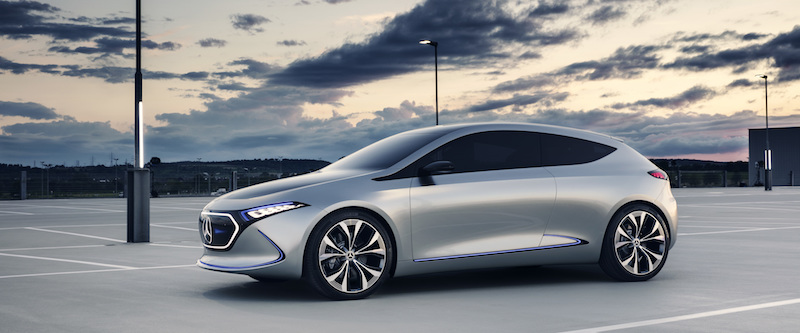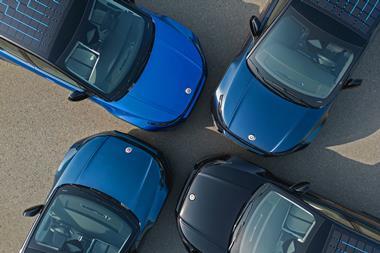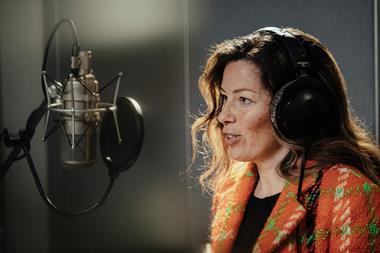As it launches ‘electric intelligence’ models, Mercedes-Benz is also adapting its factories for flexible production
 At first there was some confusion over what Mercedes-Benz meant when it announced that it was creating an ‘EQ’ division. Was it to be a line-up of cars which would directly challenge BMW’s i models, as well as Audi’s e-tron vehicles? At the 2016 Paris Motor Show, the German OEM pulled the covers off an EV concept which would become the forerunner of its new product brand for electric mobility, EQ. The name stands for ‘electric intelligence’.
At first there was some confusion over what Mercedes-Benz meant when it announced that it was creating an ‘EQ’ division. Was it to be a line-up of cars which would directly challenge BMW’s i models, as well as Audi’s e-tron vehicles? At the 2016 Paris Motor Show, the German OEM pulled the covers off an EV concept which would become the forerunner of its new product brand for electric mobility, EQ. The name stands for ‘electric intelligence’.
Scalable and flexibleWhile series production of EQ vehicles is still about a year away, there have been smaller announcements, such as the EQ Boost system in the new CLS 450 4MATIC. This has an integrated starter-generator which provides more power under acceleration. The other benefit is emissions-free driving under certain conditions. Behind the scenes, there is a lot of work going on to modify production facilities in several countries. The Sindelfingen plant, Germany, is being adapted for the manufacturing of bespoke EQ models.
Aside from the 3.0-litre engine in the CLS 450, another EQ Boost unit has already been fitted to E-Class cars made at Sindelfingen. Introduced only a few months ago, M 264 is a two-litre, four-cylinder petrol unit which produces 220kW (299hp) and 400Nm in the E 350 Coupé and E 350 Cabriolet. M 264 has twin-scroll turbochargers, a belt-driven 48-volt starter-alternator and an electric 48-volt water pump.
Introducing EQ Boost powertrains to Sindelfingen is one thing, but building fully electric models alongside them is far more complicated. Daimler says it has made a global decision to invest in flexibility and technical equipment offering Industry 4.0 technologies.

According to a Stuttgart-based company spokesman, future EVs will be “based on a vehicle architecture developed specifically for battery-electric models, which is scalable and can be applied for all models”. He adds: “We have designed and developed technological concepts for EQ vehicles that give us a maximum benefit for our customers as well as for our production processes.” The result, the spokesman says, is “a high integration compatibility of EQ-components into existing assembly buildings”.
In Germany, Bremen will be the second of three manufacturing plants adapted for the addition of battery-electric vehicles (BEVs). The first of these is coming in 2019. Highly flexible production equipment is being deployed wherever possible, and the company has said that EQ components are handled exactly as they would be during the build process for a combustion-engine vehicle.
Not only assembly lines and associated systems are seeing modifications at both Sindelfingen and Bremen. The cars themselves will have certain unique features to help with a smooth build process. Common lifting points in all vehicle variants are being designed in, as are standardised joining and assembly technologies. Therefore, even a complex process such as the marriage will take place within the same station as it would do for a non-electric model.
“Agile planning and development methods” are key to planning ahead of the introduction of the first EQ model to assembly lines, Mercedes-Benz notes. Assembly buildings, too, are in the process of being redesigned to increase flexibility and minimise the impact on existing output.
Expanding the line upThe EQC is to be the first Mercedes-Benz EV to be built in high volume. This compact crossover will be manufactured at Bremen and will enter the market in 2019. There will be one main difference between how cars are made at Bremen now and what Mercedes-Benz plans for the EQC: “We will build an additional marriage where the battery pack of each EV will be assembled into the body of the car,” the spokesman explains.
After the EQC, the carmaker plans rapidly to add more models and also to have them roll off production lines at all of its German plants. Besides Sindelfingen, that means Rastatt, which presently makes the A-Class and B-Class compact cars as well as the GLA-Class crossover. A production version of the EQA concept seems almost certain to be the model for this plant. Other locations in the global production network will be Beijing, China, and Tuscaloosa in the US. Daimler already produces electric smart models in Hambach, France. These are made on the same line as the fortwo and for-four cars with combustion engines.
What about changes which might be needed to safeguard employees? This has already happened at Hambach, and what has been learned there is being applied to six upcoming competence centres for the production of EVs. “In all our plants preparing to produce EQ models, we train our employees for the use of high-voltage technology, also in the training programmes of our apprentices,” the spokesperson states.
For competitive reasons, the company does not wish to disclose too many details of its plans. However, Mercedes will start producing SUV models of the EQ brand in Tuscaloosa at the beginning of the next decade. A battery plant will also be built near the existing car plant.
Early in the next decade, the EQ range is due to consist of multiple fully electric models, supported by many partly electric variants of existing cars. BEVs will be made in the same plants as mild hybrids, full hybrids and plug-in hybrid electric vehicles (PHEVs), each one part of the EQ sub-brand but always with a three-pointed star badge. As well as building models in Germany, Daimler intends to manufacture one or more models from its EQ range in China. The EQC will be the first of these in 2019 and will be part of BBAC, the Beijing Benz joint venture (JV).
The plug-in hybrid and fully electric model range of the EQ sub-brand should consist of four models by the early 2020s, in order of size: EQA, EQC, EQD (Porsche Mission-E rival) and EQS (large sedan).
Introducing an EV architectureDaimler has also developed an electric vehicle architecture (EVA), which is an adaptation of its rear-wheel drive and all-wheel drive architecture, as the basis for certain future EVs. This platform is scalable and usable across all models: the wheelbase and track width as well as all other system components, especially the batteries, are variable thanks to its modular design. It is to be a multi-material mix of steel, aluminium and carbon fibre, and will be suitable for SUVs, saloons, coupes, cabriolets and other bodies. Details of the EQ range’s powertrains are yet to be divulged but a two-motor system and all-wheel drive is expected.
The EQA will come one year after the arrival of the EQC. This competitor for the future VW I.D. will go on sale in Europe a few months after the I.D, each of which should be around the same size as today’s Golf and A-Class five-door hatchbacks. Both are planned for arrival in European dealerships during the first half of 2020.
"The battery is the key component of e-mobility. As batteries are the heart of our electric vehicles, we put a great emphasis on building them in our own factories" - Markus Schäfer, Mercedes-Benz
A prototype of the EQA premiered at the 2017 Frankfurt Motor Show. This all-wheel drive concept had one motor on the front axle and another for the rear wheels. Total power was said to be up to 200kW due to scalable battery components, and the range could be as much as 400km.
Powering upLater this year, a second Daimler-owned battery factory in the German town of Kamenz will come on stream. From here, packs of cells will be sent 500km west to the Bremen car plant, where they will be fitted to the EQC commencing in 2019. The factory in Kamenz will also produce cells as part of the Beijing Benz JV, at least until battery production begins in China.
Markus Schäfer is the divisional board member of Mercedes-Benz Cars with responsibility for production and supply chain. Speaking at an event in Stuttgart in January 2018, he stated: “The battery is the key component of e-mobility. As batteries are the heart of our electric vehicles, we put a great emphasis on building them in our own factories.”
The company’s global battery network is being developed with an emphasis on placing cell production locations close to vehicle plants. Schäfer claimed that, should there be a short-term spike in demand in another part of the world, “our battery factories are also well prepared for export”. He asserted: “Our global production network is ready for e-mobility”.
As well as BEVs, Mercedes-Benz has also been busy developing fuel cell electric vehicles (FCEVs). Its GLC F-Cell recently completed winter testing alongside the EQC in northern Sweden, and is set for market launch in 2019. The hydrogen tank system used in the car is produced at the Daimler Mannheim plant, while the lithium-ion battery comes from the Daimler subsidiary Deutsche Accumotive, which is located in Kamenz. Series production is being prepared for at the Bremen plant.
































